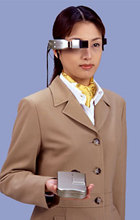DONNING YOUR PC:
Soon You Will Be Able to Wear Your Computer
March 31, 2000
 |
|
Will people "wearing" their PCs become a common sight in several years' time? (Olympus Optical Co./IBM Japan)
|
|
Mobile information terminals, such as notebook computers, are already a familiar sight. Now a wearable computer that can be attached to the user's body is under development. The first such product was nothing more than a personal organizer in the form of a wristwatch, but recently wearable computers have appeared with the same capabilities as a notebook computer and movie quality that surpasses that of televisions.
It Started as a Wristwatch
Since such research bodies as the Massachusetts Institute of Technology in the United States began advocating the concept of wearable PCs as the ultimate result of the miniaturization of computers, research and development has been proceeding worldwide. One of the first ideas consisted of dividing up the functions of a computer and distributing them in separate devices worn on various parts of the body. Due to limitations imposed by the shape and movement of the human body, however, this type has not seen very wide recognition. At present the leading design is the wristwatch model, of which a number have hit the market around the world.
The first product in this vein to be developed in Japan was a wristwatch-style mobile terminal that went on sale in summer 1998. Its face is a square liquid crystal display, and it is equipped with a port for connecting to a computer as well as an infrared receiver. With a maximum memory capacity of two megabytes, it can be used as a personal organizer, as a watch, and for processing files, playing games, and viewing pictures. The manufacturer emphasizes that "strapping the device to your wrist means you don't have to carry it around, so you won't easily misplace it."
Headphone Computer
A prototype of an even more fitting candidate for the label "wearable PC" was revealed in autumn 1999 by a foreign-owned computer manufacturer and a Japanese optical equipment maker. The main unit is about the size of a headphone stereo, measuring 141 millimeters (5.5 inches) high, 87 mm (3.4 inches) wide, and 36 mm (1.4 inches) thick, and weighing 382 grams (0.84 pounds). Though it can be carried in a pocket or attached to a belt, the machine's capabilities are on a par with notebook computers. It can handle moving pictures, and the visual display, which takes the form of a headset with a small screen that is viewed with one eye, boasts higher resolution than a color television. The computer is operated using one hand via a special controller that serves as a mouse.
The manufacturer believes the device will be useful in such operations as factory maintenance checks, gas and water meter reading, airplane maintenance, and the installing of electricity cables. Such tasks usually require a voluminous manual of procedures, but if a wearable computer were used to display the procedures instead, the worker would be able to use both hands freely, thus improving efficiency.
Technologies for the Disabled
The development of wearable computers suitable for disabled users is also continuing apace. In December 1999, for example, the same optical equipment maker announced a new input technology that allows users to control a computer via a fingertip sensor that detects hand movement. Specific finger movements correspond to commands that the user registers in advance. For instance, bending the thumb and middle finger might be equivalent to clicking a button on the screen.
As for products aimed at the hearing impaired, the computer industry is pursuing the development of more user-friendly functions, including the ability to input using sign language.
While the race for higher-performing hardware and software is set to continue, the industry is now facing up to a new challenge--that of offering a broader choice in the shape and form of computers to suit various people's needs. It appears that there are still many miles left to travel along the road of computer development.
 Edited
by Japan Echo Inc. based on domestic Japanese news sources. Articles presented
here are offered for reference purposes and do not necessarily represent
the policy or views of the Japanese Government.
| 


















